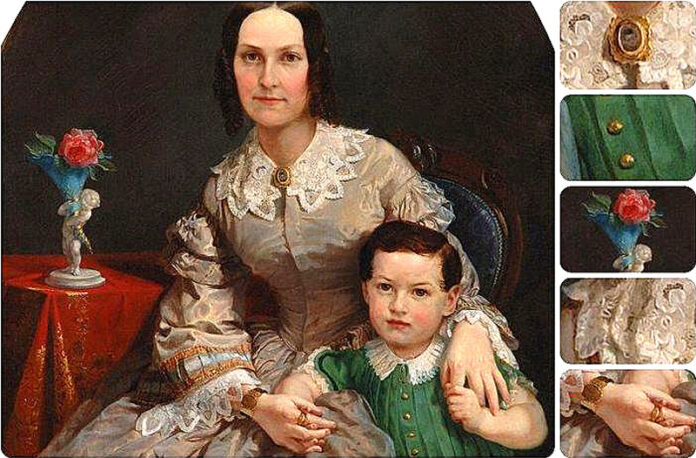
Your son, age 6, dies. Two years later your one-year-old boy dies. Bad things come in threes, and just two years later, after your wife gives birth to another boy, infection sets in and takes her life. How would you cope with such loss?
I often wonder how Rowland B. Lacey felt in 1857 when he contacted Lilly Martin Spencer to capture the images of his wife and two sons on canvas. For you see, it was Rowland who lived through the Hell outlined above. It was Rowland who in 1852 lost his six-year-old son, Edward, and who three years later lost his one-year-old son Henry to dehydration resulting from diarrhea. In 1857, Rowland had to watch his wife pass away after she brought a third son, David, into the world.
Over the course of 1857, Lilly Martin Spencer memorialized Jane, Edward, and Henry through portraiture. Rowland sent Spencer photographs of his family along with various forms of mourning jewelry for her to use to create the portrait; a portrait that is part of Roanoke, Taubman Museum of Art’s permanent collection. The portrait becomes a smorgasbord of an iconography of death as several objects serve as clear symbols of mourning, including a slightly wilted rose along with two postmortem rings on Jane’s right pointer finger, her mourning bracelet, the flowers in her lace collar, and her brooch. However, the most creative icon of death is found in Edward’s buttons. The buttons on his shirt are roses – some closed, some open. This is a clear reference to the transience of life.
When glancing at the portrait only two subjects are at first apparent: Jane and Edward. However, in Jane’s brooch is a black and white image of a young boy – it is Henry. This is a reproduction of a postmortem photograph. Rowland had sent to Spencer the brooch that his wife had worn to memorialize their son.
Recently, the Taubman Museum decided to lay the painting to rest in the vault. More noteworthy is that the museum decided to display a contemporary version of the painting in the atrium. I know the person who created this reproduction, and I respect him as an artist and what he has done. The gridding process he used to reproduce the painting is fascinating.
However, two significant elements warrant reflection. First, in the reproduction, the likeness of Henry is lost; it is just a smudge of grey paint. Second, two holes now replace the faces of Jane and Edward. The holes allow individuals to stand behind the work and put their faces in the place of Jane and Edward’s faces. You can take the position of those that Rowland loved so dearly and for whom he turned to art to find comfort in their deaths.
Are these decisions on the part of the museum appropriate? I cannot be the judge as I am personally attached to the painting of Jane, Edward, and Henry. It was my research that uncovered the postmortem elements of the work. But if a museum’s role is to respect the works of art in its collection and to educate the community, then the decision to turn the work into an almost carnival type experience may be out of line with the Taubman’s asserted professional standards related to “meeting all museological and educational standards.”
Ultimately it is up to each person to decide how the painting should be engaged. Perhaps it is fitting at this point to reflect on an excerpt from a letter written to Lilly Martin Spencer in March 1882. In the letter, Mrs. Thomas Brown, a mother who commissioned Spencer to paint a portrait of her deceased daughter, Laura, writes:
“You cannot paint her too beautiful for my imagination.
To me she was all that is lovely – a sweet sympathizing friend – sister and daughter, all in one – and I long for the time when I can once more
gaze upon those features – silent tho they be. Those eyes will look at me once more. Those lips shall speak tho in tones too soft for mortal ear to hear.
Though silent in body our Spirits are still as one.
God grant your genius may grow brighter, and the conception be a perfect Laura Brown.”
If Rowland cared for his family half as much as Mrs. Brown did for her daughter, how would he feel if he knew the faces of his wife and son were now gone and children and adults were filling those spaces with their faces? If it were your family, how would you feel?
– B. Scott Crawford, Roanoke



I agree with rpgivpgmr….the Taubman is again showing a clear disconnect, but not just with the public, but with the art itself.
Just curious- how much $$ did the Taubman pay the artist to create the carnival piece? And in a time when they’re so deeply in the red? Was that truly the best investment of money & effort?
As a postscript- B.Scott Crawford has given me some great thoughts to consider the next time I paint a commissioned piece. A very well-written article.
You are exactly right in my humble opinion.
The Taubman Art Museum has always had a disconnect in overtly attempting to make art a ‘hands on’ experience in Roanoke. That said, a grand solution would be to display the artwork again and have a close-by area available for a photo with this new idea. They have a lot of free space to easily do that. The artwork should always have precidence, not artwork related gameshots. I would wonder personally why this was done with a painting at all.
Very nice explanation of a commissioned artwork. Thanks.